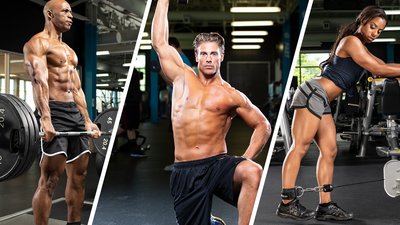Odds are, you know someone who has hurt their back in the gym. The fact of the matter is that many of the exercises we do in the gym are not inherently bad for the human back. What can be very bad, though, is the way people sometimes do them.
If using bad form has twisted and torqued your body out of shape, your first move should be heading straight for the new Bodybuilding.com BodyFit Elite program Unstoppable: The Ultimate Guide To Training Through Injury.
In the meantime, here are three of the most common exercises that cause back pain when done improperly, each with a simple modification that could save you months, or perhaps even a lifetime, of grief.
Tweak 1. Start High on the Deadlift
The deadlift is an amazing exercise we use every day in our clinic to rehab people with lower back pain. So why do so many people develop lower back pain from deadlifting? It's the round.
Done correctly, the deadlift is intended to stiffen your spine and get you to drive through your hips. However, most people tend to slacken their spine like a fishing rod bending under the weight of a prize tuna. Use a fishing rod designed for a trout to land that bluefin, and it's goodbye rod!

The Modification: Instead of starting your deadlift with the weights on the ground, start with them 9 inches or so higher off the floor. This elevated position gives those with less mobile hips (i.e., nearly everyone) the ability to lift the weight without rounding their spine. You'll still grab virtually all the same benefits as a ground lift, only with much lower risk.
Tweak 2. Hit the Deck for the Military Press
Just as immobile hip joints can make the deadlift a dangerous move, immobile shoulders can make the military press unnecessarily risky. The problem is that immobile shoulders force lifters to arch their back excessively during overhead presses, especially when heavier weights are involved.

The Modification: Replace the military press with the half-kneeling dumbbell shoulder press. Half-kneeling means having one knee on the round and the opposing foot out in front of it, in split-squat fashion. This locks the pelvis and spine into a more fixed position, which helps engage your transverse abdominal muscles. These muscles hold your spine in a neutral position.
Tweak 3. Drive Long on the Glute Kick-back
Then there's the Instagram-fueled booty-building craze. Promoters of this trend are no dummies; they have the models arch their backs during kick-backs to demonstrate miraculous glute growth! The problem is that this leads more and more people to perform this otherwise great exercise with an excessive arch in their spine.

The Modification: Several cues can help you do this move correctly.
- Drive "long" with the heel, not high toward the ceiling. Visualize trying to break your heel through the wall on the other side of the room.
- Act as if there's a glass of red wine on your upper back and one on your lower back as you perform kick-backs on a very expensive white rug. To make sure you don't spill a drop, keep your torso still and square to the floor, and don't round your back.
- Place a business card or sticker on the floor directly below your face. Keep your eyes down and focused on it during the reps.
These three exercises can either dramatically improve your physique or set you up for a lifetime of back-pain agony. It all comes down to your form.



